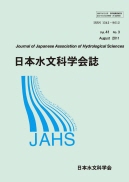Volume 41, Issue 3
SPECIAL ISSUE : "Nitrogen contamination in environmental water - role of hydrology as an integrated science - "
Displaying 1-9 of 9 articles from this issue
- |<
- <
- 1
- >
- >|
FOREWORD
-
2011 Volume 41 Issue 3 Pages 47-48
Published: 2011
Released on J-STAGE: January 16, 2012
Download PDF (159K)
GENERAL ARTICLE
-
2011 Volume 41 Issue 3 Pages 49-53
Published: 2011
Released on J-STAGE: January 16, 2012
Download PDF (664K) -
2011 Volume 41 Issue 3 Pages 55-61
Published: 2011
Released on J-STAGE: January 16, 2012
Download PDF (712K) -
2011 Volume 41 Issue 3 Pages 63-70
Published: 2011
Released on J-STAGE: January 16, 2012
Download PDF (1646K) -
2011 Volume 41 Issue 3 Pages 71-78
Published: 2011
Released on J-STAGE: January 16, 2012
Download PDF (637K) -
2011 Volume 41 Issue 3 Pages 79-89
Published: 2011
Released on J-STAGE: January 16, 2012
Download PDF (1565K) -
2011 Volume 41 Issue 3 Pages 91-101
Published: 2011
Released on J-STAGE: January 16, 2012
Download PDF (843K)
SERIES
-
2011 Volume 41 Issue 3 Pages 103-110
Published: 2011
Released on J-STAGE: January 16, 2012
Download PDF (1666K)
REPORTS
-
2011 Volume 41 Issue 3 Pages 111-112
Published: 2011
Released on J-STAGE: January 16, 2012
Download PDF (603K)
- |<
- <
- 1
- >
- >|
